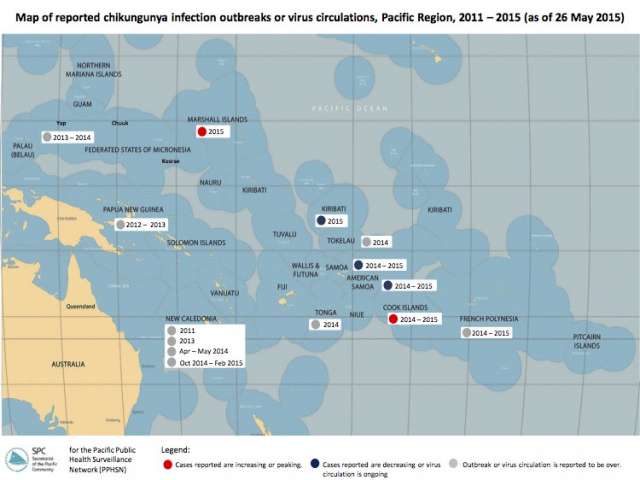The chikungunya virus has now reached half of the Pacific Island countries and territories and is likely to continue spreading to non-affected countries in the region and other parts of the world.
Surveillance experts at the Secretariat of the Pacific Community (SPC) closely monitor this emerging disease in collaboration with countries, territories and regional partners of the Pacific Public Health Surveillance Network.
Since 2011, when the first outbreak of chikungunya was detected in the Pacific region (in New Caledonia), 14 chikungunya virus outbreaks and circulations have been reported by 11 of the 22 Pacific Island countries and territories.
“As anticipated, the virus has been spreading rapidly and causing significant outbreaks in the Pacific region, similar to what was witnessed in the Indian Ocean region in 2005–2007,” the Deputy Director of SPC’s Public Health Division, Dr Yvan Souarès, said.
“We estimate that it will continue to spread for some years due to a number of factors, mainly the low immunity of the populations in the non-affected countries, the presence of mosquitoes capable of transmitting the virus in most parts of the region, the weakness of mosquito control resources in most Pacific Island countries and the high mobility of the population,” Dr Souarès added.
People travelling to, or staying in, countries where chikungunya is circulating can take measures to avoid contracting and spreading the disease by protecting themselves from mosquito bites and contributing to mosquito control efforts.
SPC maintains an interactive web-based map showing where chikungunya and other emerging and epidemic diseases are currently circulating in the region: spc.int/phd/epidemics
If people are ill while staying in or coming back from affected countries, with the following symptoms — high fever (>38°C) and joint pains (other common symptoms include muscle pain, headache, nausea, fatigue and skin rash) ̶ they should think of chikungunya and quickly consult a doctor for diagnosis.
The symptoms are similar to those of dengue disease which is also currently circulating in the region.
The often-prolonged joint pain, especially in small joints like hands and feet, is particular to chikungunya.
The pain can be debilitating and last several months therefore badly affect daily activities and livelihoods of sick people and impact the economy of affected communities.
“It is important for people to consult a medical professional when they feel ill, both for their own health and also to limit the spread of this kind of diseases to other people in the region, and beyond, when travelling,” Dr Souarès stressed.
The innovative online health surveillance tool is part of a comprehensive response by SPC and regional partners of the Pacific Public Health Surveillance Network to assist Pacific Island countries and territories in their efforts to strengthening surveillance and response measures and better protect Pacific populations from chikungunya and other emerging diseases.
It is made possible with funding from the Australian Government, the New Zealand Aid Programme and the French Pacific Fund.




